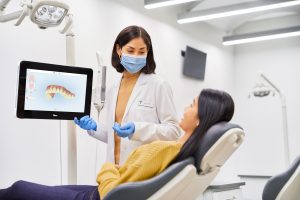Invisalign First could be an option for your child if they need orthodontic treatment, but aren’t keen on fixed dental braces. Invisalign clear aligners are a great alternative to fixed braces for a few reasons: they are comfortable, removable, and barely visible when worn.
Many people assume Invisalign treatment is just for adults and teens when in fact, Invisalign First is an orthodontic treatment specifically for children.
It may not, however, be suitable or necessary for all kids who need teeth straightening. This article will discuss everything you need to know about Invisalign First and answer the following questions:
- What is Invisalign for kids?
- Who is eligible for this treatment?
- How does Invisalign First work?
- What are the advantages and disadvantages?
- How is Invisalign for children different from other Invisalign options?
If you want the best for your children’s teeth and don’t want them to have uncomfortable fixed braces, keep reading to learn more about Invisalign First.
This aligner system could be the answer you’re looking for if you don’t think traditional braces are right for your child.
So, let’s get started and find out exactly what Invisalign for children is.
Depending on the severity of your child’s orthodontic condition, Invisalign First can cost anywhere between £2,500 and £5,000, with prices varying between dentists and practices. Therefore, it is not a bad idea to compare prices from multiple providers.
What is Invisalign for kids?

Invisalign First is Align Technology’s clear aligner system for young children aged 6-10 who need orthodontic treatment. It is a more comfortable and less visible alternative to traditional braces, which may be preferable for some kids.
Invisalign for kids is an early intervention treatment for spacing and overcrowding issues of the baby teeth. It can help with arch development, correcting protruding teeth, and also improving the overall appearance of a child’s smile.
If you have heard of Invisalign aligners before then you may already know that they are removable, custom-made, clear plastic trays that fit snugly to your teeth. Treatment consists of a series of trays that you change every couple of weeks as they use pressure to gradually align your teeth and bite.
Who is eligible for treatment with Invisalign First?
Invisalign First is only for children aged between 6-10 whose jaw is still growing. This aligner system helps correct the positioning of the jaw to prevent future orthodontic problems. Some of the issues that Invisalign First can treat in children are:
- Arch development
- Expansion of narrow arches
- Spacing between teeth or overcrowding
- Overbites, underbites, crossbites and overjets
- Protruding teeth
- Aesthetic alignment of the teeth
The following video shows some of the different dental issues that Invisalign First can treat and some of the benefits of these aligners:
Some kids may still need treatment with fixed braces, especially if their orthodontic case is severe. If you are not sure, you can use Invisalign’s Smile Assessment tool to find out if your child is eligible, or make an appointment with your nearest provider for an assessment.
Invisalign vs braces for kids
The main difference between Invisalign and traditional braces is that Invisalign aligners are removable and barely visible, whereas braces are noticeable and permanently fixed to the teeth. There are benefits and drawbacks to both types of orthodontic treatment, and depending on your child’s case, the choice may or may not be obvious.
Metal braces and orthodontic appliances are usually recommended in more severe cases. However, Invisalign for kids may be more suitable for your child’s particular case. So, let’s take a closer look at the advantages and disadvantages when it comes to Invisalign vs braces for kids.

Braces are fixed to your child’s teeth so even when they find them uncomfortable they cannot remove them. While this may sound harsh, the occasional discomfort of orthodontic treatment is worth it for the end results. Aligners must be kept on for the full 20 – 22 hours, and will not work if your child removes them often.
Invisalign aligners are more comfortable than fixed braces, which can be sharp and uncomfortable on the cheeks and gums. The fact that they are removable means that cleaning them and your child’s teeth is much easier. Braces take much longer to clean and require different equipment to fully clean beneath and around the wires and brackets.
Removable aligners also make eating easier as your child can remove their aligners to eat, whereas they would have to avoid certain foods with braces. Kids are also able to remove aligners for sports, whereas with fixed braces they must wear a mouth guard or risk damage to their braces and gums.
The following table summarises the advantages and disadvantages of both Invisalign aligners and fixed braces:
Invisalign First | Traditional braces | |
Advantages |
|
|
Disadvantages |
|
|
What does Invisalign First cost in the UK?
Invisalign First costs roughly between £2,500 and £5,000 depending on the severity of your child’s orthodontic case, and prices can vary between dentists and from practice to practice. So it’s not a bad idea to shop around and get quotes from a few different providers.
When it comes to pricing, keep in mind that individual quotes for Invisalign will vary — you can call 866-383-0748 to find an Invisalign dentist near you who can give you a detailed price quote.
How does Invisalign First work?
Invisalign for kids works by using a series of clear plastic aligners to align the jaw and straighten the teeth. The difference between this and the other Invisalign treatment options is that there are a few extra features designed to treat the growing jaw.
These clear aligners don’t just straighten teeth and align the bite, they actually expand and change the shape of your child’s growing jaw. This is also known as palatial arch expansion, which is the process of applying pressure to the teeth to increase the dental arch width.
The first step to finding out if your child is eligible is to speak to an Invisalign dentist or orthodontist. It is important to note that you can’t get Invisalign on the NHS, or any other type of clear aligner, even for children. So, if your child’s regular NHS dentist is also an Invisalign doctor, they will need to be seen as a private patient. If they aren’t a provider, you can easily find one near you and book an appointment to find out if your child is eligible and more.
The next steps are as follows:

- A 3D scan of your kid’s teeth and bite lets the dentist assess whether they would be a good candidate for treatment
- A digital plan and overview of your child’s treatment will be generated
- If your child is eligible for treatment they will receive their first set of custom aligners a few weeks later
- The dentist will help fit the aligners and schedule check-up appointments
- Your child will change aligners when the dentist recommends they are ready
- Once your child has completed treatment they will need to wear a retainer to keep their teeth in position
At the end of treatment, your child’s dentist or orthodontist will provide a retainer and give instructions for wearing it. Your child may need an additional course of treatment with Invisalign Comprehensive for teenagers when they are older and their teeth are more developed.
What are the other Invisalign treatment options?
The Invisalign system offers a few different levels of treatment, depending on the severity of your orthodontic case. Invisalign First is the only option for children between the ages of 6 and 10, and older children may be able to start with one of the following options.
If you or your teenager are eligible for treatment, your Invisalign doctor will assess your teeth and decide which one is suitable for you. These different levels include:
Each of these options uses the same clear aligners. The main difference between them is the severity of cases that can be treated and the treatment length. The following table summarises these options and their costs.
Type of Invisalign treatment | Comprehensive | Lite | Express |
Cost estimate | £3,500 – £5,500 | £2,500 – £4,000 | £1,500 – £3,000 |
Treatment length | 12-18 months | 6-8 months | 3+ months |
Suitable for | Moderate and complex cases | Mild and moderate cases | Mild and aesthetic cases |
How is Invisalign First different from other Invisalign options?
There are a few features of Invisalign First aligners which are specifically designed for treating children and are not included with the other options. These include:
Blue wear indicators: These indicators are at the back of the aligners and fade from blue to clear when the aligners have been worn for a certain amount of time. This is so dentists and parents know that the child has worn their aligners for the appropriate amount of time each day.
Eruption compensators: These are special features that allow for canines, second premolars and second molars to grow in naturally without affecting the aligners and treatment.
Mandibular advancement precision wings: These are wings on the top and bottom aligners that interlock and work together to align the jaw and move it into a better position. This is a relatively new technology, and while studies show that it has good results, more research is needed on the longer-term effects.

Conclusion
Clear aligners are commonly thought to be just an orthodontic treatment for adults and teenagers. However, that isn’t true! Invisalign First is designed to treat a child’s growing jaw for early intervention of future orthodontic issues.
Invisalign First is suitable for children between the ages of 6 – 10 while they still have most of their baby teeth. It can be used to expand the jaw, help with crowding and spacing issues, or even just for aesthetic purposes.
There are a few special design features that make Invisalign First a good solution for your kids. These include blue wear indicators and eruption compensators. Your child may also need buttons and attachments on their aligners to help their treatment progress.
If you want to know whether your child is eligible for treatment with Invisalign for children, you can take Invisalign’s free Smile Assessment for them. Just fill in your child’s details and get an answer back straight away.
However, this may be something you prefer to discuss in person with an Invisalign provider. If that’s the case, then use Invisalign’s search tool to find your nearest provider and book an appointment.
Keep in mind that before you opt for any at-home treatment, visit your dentist for a general check-up to ensure there aren’t any untreated cavities or gum disease before wearing aligners. Your dentist can also assess your overall suitability for any aligner treatment.
ResearchGate. Aligners and Mandibular Advancement: A Comprehensive Option for Phase I Treatment of Class II, Division 1 Cases. Consulted 7th January 2022.
Prices stated are indicative only and are based on publicised treatment prices at dental clinics across the UK.




